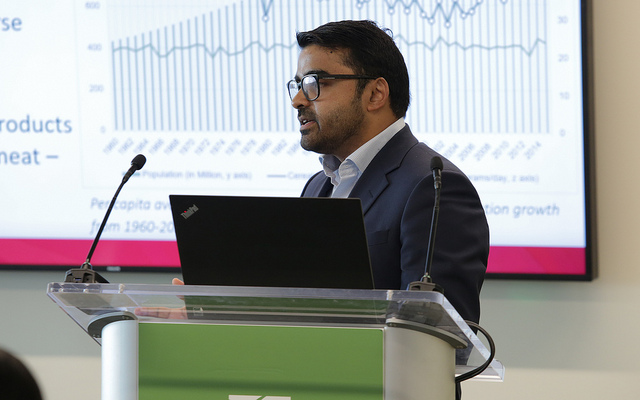The global food system is at a crossroads, and it is up to policymakers, practitioners, and researchers to reshape the agriculture sector and break the cycle of malnutrition, a panel of researchers—authors featured in a new book, Agriculture for Improved Nutrition: Seizing the Momentum—told an audience at IFPRI on Feb. 28. The book, published by IFPRI and CABI and edited by IFPRI’s Shenggen Fan, Sivan Yosef, and Rajul Pandya-Lorch, reviews research findings, results from on-the-ground programs and interventions, and country policy experiences from the past 5-10 years that are bringing agriculture and nutrition closer together.
“Nutrition-sensitive agricultural programs work. Many programs are well thought-out, well-designed, and better-evaluated than programs that have been evaluated in the past,” said Marie Ruel, director of IFPRI’s Poverty, Health, and Nutrition Division (PHND) and author of a chapter that reviews what we have learned from agriculture-nutrition programming. A growing body of research shows that integrated programs can positively impact household and individual diet diversity, and sometimes micronutrient status, such as vitamin-A status. However, she said, these programs also appear limited in their ability to impact child stunting (low height for age), even when they have strong designs and rigorous evaluations.
Olivier Ecker, a senior research fellow in IFPRI’s Development Strategy and Governance Division (DSGD) and author of a chapter on obesity, noted that more than 1 in 8 adults globally are now obese. Ecker explained, “The prices of the most common cereals—rice, wheat, and maize—dropped by about 50 percent from 1970 to the late 1990s. At the same time, the price of beef declined by 68 percent and that of milk, by roughly 40 percent.” The falling prices helped to reduce hunger, but as these foods became widely affordable, they have also contributed to poor diets and overnutrition.
In both rich and poor countries, reducing or eliminating agricultural incentives that lower the costs of a calorie-dense and animal protein-rich diet (relative to a more diversified and healthier diet) is a key tool to address this problem. But, Ecker warned, reforms targeting agricultural subsidies, for example, could also harm farmers’ livelihoods—and so should be accompanied by safety net programs to assure that poor farm households are not left behind.
Mathew Abraham, assistant director of the Tata-Cornell Institute and co-author of a chapter on India’s experience in agriculture-nutrition, underscored this point. India has traditionally promoted major cereals to meet the population’s calorie requirements, in effect crowding out nutrient-rich coarse grains and pulses. Poor infrastructure for storing and transporting perishable foods such as fruits, vegetables, and dairy have further hindered many Indians’ access to nutritious, diverse diets, he said.
“An integral part of the malnutrition story in India is its regional variations,” Abraham said. “In the [least developed] states, performance on child stunting and underweight has been poor, whereas in the more agriculturally-developed and urbanizing states, the performance has been better.” These latter developed states, however, now face rising rates of overweight and obesity—a looming public health crisis.
Two more authors offered their perspectives through video messages. Noora-Lisa Aberman, an associate research fellow in IFPRI’s Ghana Strategy Support Program, explained that Malawi’s singular policy focus on maize production is an obstacle to progress on achieving dietary diversity. She urged policy makers to reframe the national conversation around nutrition. Ruthie Musker, strategic projects and partnerships lead for Global Open Data for Agriculture and Nutrition (GODAN), described the huge potential of big data in agriculture-nutrition, from satellite collection of soil quality data to analyzing consumers’ nutrition through social media analytics. She called for making data accessible to all segments of society, compensating people for the use of their data, and updating the governance structures around open data.
Now is the time to seize the momentum to reshape agriculture for nutrition, said IFPRI Director General Shenggen Fan, a co-editor of the book. “Agriculture provides food for 7.6 billion people,” he noted, “It has a vast potential to do more to address not only undernutrition, but also make sure that overnutrition and obesity will not be a challenge for us in the future.” Many unknowns remain in the field, and research, policy, and programs will be critical to fill the knowledge gaps. It is up to the development community to build up the evidence base and drive action that can transform the agri-food system—and ultimately achieve the Sustainable Development Goals (SDGs) by 2030.
Sivan Yosef is a Senior Program Manager with IFPRI’s Director General’s Office. Read more about the book and the expanding links between agriculture and nutrition in our blog series here and here.







